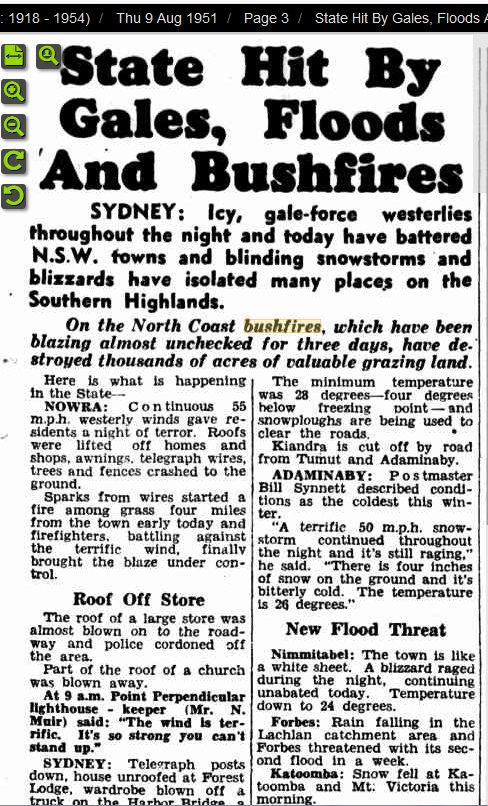Our thoughts go out to people who have lost property or been affected. The point has been made at this blog that we need large multi-engined air tankers based here year round and having them operated by the RAAF is the best way to use those aircraft efficiently.

Just now there are 89 fires listed across NSW and I expect most would be in remote areas quietly burning similar to hazard reduction burns.
How frequent have winter bush fires been in, say, the past hundred years in Oz? The Fairfax media on this side of The Ditch are presenting the present blazes as a consequence of climate change and that they will become the future norm.
Any reliable data out there?
I expect lightning strikes have caused ignitions during past dry winters and if they were near people there may be references in old newspaper files. I am busy for a week but I will ask an expert if he can check. This NASA site is interesting but I can not slow the thing. Seems to have been plenty winter fires in Oz. This page shows August 2007 there were fires in eastern Australia. August 2017 too shows many fires in eastern Australia.
Quick search in TROVE The search needs confining to winter.


But a few results
This from Bendigo ex Sydney 27Aug1895 – Extensive bush fires are raging in the Macleay River district. Many narrow escapes are reported.
and from early August 1951
seems nothing is really new – some in society can choose to have a short memory.
More the result of poor management, such as lack of hazard reduction burning. I spent 18 years in a fire surveillance role in SW WA. There will always be ignitions but it’s a matter of fuel levels and weather conditions as to whether the fire is controlled early. Most fires are from a few hectares to tens of hectares, but you never hear about them unless they are on or near the urban interface.
Going back to the second last fire season that I worked in the surveillance role, in the SW corner of WA there were almost 100 lightning caused fires, only two made the media.
1953
“BUSHFIRES AND FROSTS”
trove.nla.gov.au/newspaper/article/150520931
1941
“RICHMOND BUSHFIRES”
trove.nla.gov.au/newspaper/article/61744772
1912
BALHANNAH, August 21
As showing the unseasonableness of
the weather we are experiencing here
this week a bush fire broke out in Mr.
Camac’s paddock, and spread in to Mr.
Grasby’s burning a lot of timber.
trove.nla.gov.au/newspaper/article/124820956
1935
“A bush fire in August, with the
bush still dripping from melting
snow, is very unusual, but such was
the case on Tuesday afternoon,…”
trove.nla.gov.au/newspaper/article/193895856
1926
“MOUNT ALFORD BUSH FIRE”
trove.nla.gov.au/newspaper/article/177771090
1906
“SERIOUS BUSH FIRE.
BRISBANE, August 27.
A bush firo broke out on
Saturday in Langton’s country
on the Wellshot resumption area.
Tho fire extended over miles of
tho selection, which was practically
burnt out.”
trove.nla.gov.au/newspaper/article/12822294
1972
Acting on the recommendation of the Fire Control Officer and
representatives of the Forestry Commission of N.S.W. and A.P.M. Forests Ltd., the Shire President has proclaimed a Bush Fire Danger Period for the whole of the shire from 18th August to 30th September,1972, when the statutory danger period
normally commences.”
trove.nla.gov.au/newspaper/article/247257469
1940
“The secretary of the Bushfires Advisory Committee (Mr. Mack) issued a special warning about the danger of bushfires. Hot weather combined with fierce winds would sweep the fires through miles of wood in its present dry state, he said. He pleaded for the co-operation of every person to prevent outbreaks.
trove.nla.gov.au/newspaper/article/111591646
1952
“While snow fell over a wide area of N.S.W. yesterday, firemen fought a big bushfire which threatened several homes at Deewhy Heights. Since ‘Friday more than 40 firemen from eight stations have been dealing with bushfires in the far north suburbs.”
trove.nla.gov.au/newspaper/article/18516953
Thanks for digging out more examples Siliggy.
So it seems nothing about bush fires in winter is really new.
1943
“While Sydney shivered and snow was falling on the. highlands this week, firemen were fighting five bush fires. Large areas of bush were burnt.”
trove.nla.gov.au/newspaper/article/236532152
1951 (October)
“BUSHFIRES, HEAVY SNOW REPORTED”
“While the temperature at Kosciusko at 9 am today was freezing
point (32 degrees), bushfires were still raging in north-west NSW.”
trove.nla.gov.au/newspaper/article/229733425
1935
“30 BUSH FIRES RING
CITY AS SNOW COVERS COUNTRY”
trove.nla.gov.au/newspaper/article/231281553